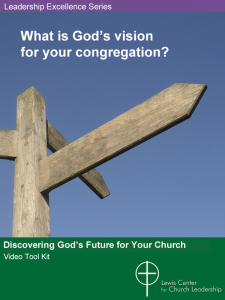David Gilmore says the size of a congregation need not be a determining factor in its ability to connect with its neighbors. Small congregations who are intentional about finding their niche, empowering laity, focusing outward, and collaborating can be just as vital as larger congregations.
Size would seemingly dictate the ability of a congregation to do missional ministry. But the truth is, size should never be an impediment or an excuse. Small congregations can have vibrant ministries that meet the spiritual and physical needs of those inside and outside the church. While there is no magic formula for making this happen, here are some lessons I’ve gleaned from congregations I know.
1. Don’t try to be everything to everyone.
The truth is, no congregation can be all things to all people, no matter its size. But it’s particularly important for a smaller congregation to find the best way to deploy its gifts and resources. This doesn’t mean things can never change, but it does mean being intentional about missional focus. For instance, the members of Oakland United Methodist Church in Buckner, Missouri, know that spreading themselves too thin dilutes the effectiveness of their ministries. So, this church leans into the needs of the community as detailed by the Community Services League of Buckner, a nonprofit organization dedicated to meeting people’s immediate needs. The church couples this knowledge of community needs with the passions and gifts of their members to find their niche. This approach allows the church to address the needs of the whole person and provide meaning and relevancy to the faith community, without spreading themselves too thin or having to work outside their unique gifts and passions.
2. Equip and empower laity.
The idea of a “one pastor show” typically leads to burnout and does not benefit the overall congregation. In many small congregations, laity are the engines that drive the faith community. This is not a diminution of the pastor’s role, but a recognition that the laity have to use their gifts to support the mission of the church. Equipping the laity to use their gifts for ministry is essential. This means having an eye toward formation and helping laity grow spiritually. It means giving the laity opportunities to share their gifts both inside and outside the church.
3. Outwardly focused community ministry can be a means of evangelism.
It’s easy for a small congregation to become inwardly focused. It happens naturally as we develop an affinity for the people in our Sunday school classes or sitting next to us in the pews. Before long, these encounters become our primary focus and we forget about reaching out beyond the walls of the church. Regardless of size, every church needs to be intentional about reaching out.
Returning to the example of Oakland UMC, of all the many ministries in which this church engages, only two or three are housed on church property. Oakland is most present in their community presence beyond the walls of their church building. In a meeting with the lay leadership of Oakland UMC, every person in the room shared that they became a member of the church because of the church’s presence and impact in the community beyond their faith community.
4. Collaboration has more impact than going it alone.
Too often congregations feel like they are competing against the other faith communities in the area. Oakland UMC, for example, is one of 13 named faith communities in a town with a population of 3,045. Instead of thinking about what can be accomplished together, these congregations often go it alone. But this is generally not the best use of a small congregation’s resources. In most cases, an individual congregation simply cannot have the kind of impact working on its own as it could by partnering with others in the community. So, for instance, instead of launching a new feeding ministry, could your church participate in a feeding ministry hosted by other faith communities in your area? The goal should be to make a difference in the lives of others, not to be acknowledged as the focal point of the ministry effort. A collaborative approach allows resources to be pooled together in a manner that more effectively ministers to the whole person. And people may well be drawn to a church seen as willing to partner and focus on the needs of the community.
The size of a congregation need not be a determining factor in its ability to connect with its neighbors. Small congregations who are intentional about finding their niche, empowering laity, focusing outward, and collaborating can be just as vital as larger congregations.
 Related Resources
Related Resources
- Change and the Small Church by Roy L. Spore
- 3 Indicators of a Thriving Rural Congregation by Allen T. Stanton
- Small Church Big Impact by Blake Bradford
- Discovering God’s Future For Your Church Video Tool Kit







